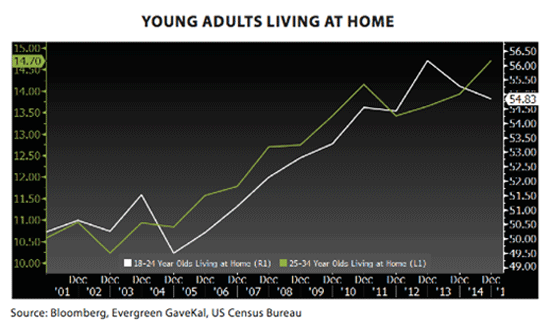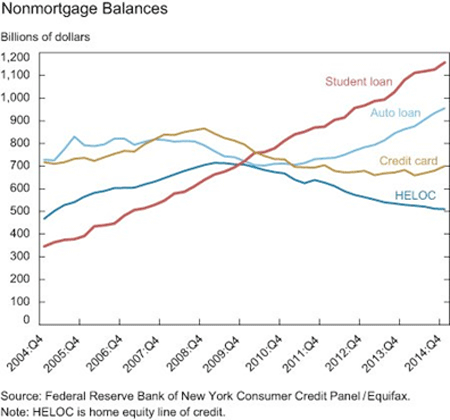It made me laugh.
One of my sons brought me to Bring Your Father to School Day when he was in kindergarten. Each child took turns introducing their father and explaining what he did for a living.
“My dad makes houses.”
“My dad drives a truck.”
“My dad cooks food.”
When my son introduced me, he said, “My dad looks at a computer.”
My son wasn’t far from being right. If you’re like me, you spend a lot of time reading; reading about the economy and the markets.
I spend three to four hours a day reading, and in addition to all the major financial publications like the Wall Street Journal and Financial Times, there are a couple dozen e-letters I read more faithfully than my parents did the Bible.
One of my absolute favorites is written by David Hay of Evergreen Capital Management in Bellevue, Washington. If you like John Mauldin’s Thoughts From The Frontline, you will love Hay’s Evergreen Virtual Advisor, which is free and is published once a week.

Above is a chart (one of many) from Hay’s most recent e-letter. It really hit home with me because I have three children in their 20s. They’re all currently in college, but the job situation for young adults is so bleak that a growing number of them have moved back home into mom and dad’s basement.

My daughter, Keiko, interning at Root Sports.
All these “boomerang” kids speak volumes about the current job market and the (deteriorating) state of the economy.
Don’t let the improving jobs numbers fool you. The April unemployment rate dropped to 5.4% from 5.5% in March, the lowest rate since May 2008. However, the jobs situation for 18- to 29-year-olds is awful.
Generation Opportunity, a non-partisan youth advocacy organization, reported that while the official unemployment rate for 18- to 29-year-olds is 7.9%, it’s actually 13.8% if you include those who have given up looking for work.
Generation Opportunity estimates that an additional 1.8 million young adults should be counted as unemployed by the Department of Labor because they are not in the labor force.
Not only are young adults not finding jobs, millions of them are saddled with huge student loan debts. According to the Center for American Progress, over 40 million Americans have student loan debt totaling $1.3 trillion, with the average loan balance around $27,000.

Student loans are a serious problem, but Americans of all ages are taking on more car and credit debt than ever.
High unemployment and high debt are a toxic combination, so you don’t have to look too far to understand why retail sales—despite the substantial drop in gas prices—are slumping.

The Commerce Department reported that retail sales—excluding automobiles, gas, and food—were also unchanged in April, well below the 0.5% increase that Wall Street was expecting.

Some of the hardest-hit retailers are those that cater to the basement-dwelling 18- to 29-year-olds. In the last two weeks…
- Buckle Inc., a young-adult clothing chain, reported lower-than-expected sales and profits.
- Urban Outfitters reported weaker-than-expected same-store sales and profits.
- Kate Spade, my daughter’s favorite fashion designer, reported a $55 million quarterly loss!
Perhaps the biggest retail warning sign of all came from Walmart.
Walmart is struggling with several problems beyond cash-strapped millennials—such as the strong dollar, employee wage increases, consumer wallet tightening, and surprising weakness in its e-commerce business—but it is definitely struggling.

On a year-over-year basis, quarterly revenue fell to $114.83 billion from $114.96 billion and shy of consensus forecasts of $116.3 billion. This isn’t a one-quarter slip either. Other than in Q3 of 2014, Walmart has reported eight out of nine quarters of shrinking sales.
Walmart isn’t very optimistic about the current quarter either; management now expects to earn $1.06-$1.18 per share, largely below the average analyst estimate of $1.17.
So what does this mean for us?
The US is certainly a consumer-driven economy, and the consumer is looking pretty sickly to me. Remember the horrible GDP numbers from the first quarter? There’s more where that came from.
Do you own any retail stocks? If yes, you better take a very critical look at them and evaluate how sensitive they are to the economic cycle. At a minimum, I highly recommend the use of protective stops to protect yourself from big drops.
Another way to hedge your bets is to look away from the US and into China, where a pending “October Surprise” promises to take yuan-denominated assets to the moon.
In any case, if you’re an empty-nester, maybe you should tidy up your basement. You may have some long-term guests moving in soon.

Tony Sagami
30-year market expert Tony Sagami leads the Yield Shark and Rational Bear advisories at Mauldin Economics. To learn more about Yield Shark and how it helps you maximize dividend income, click here. To learn more about Rational Bear and how you can use it to benefit from falling stocks and sectors, click here.

